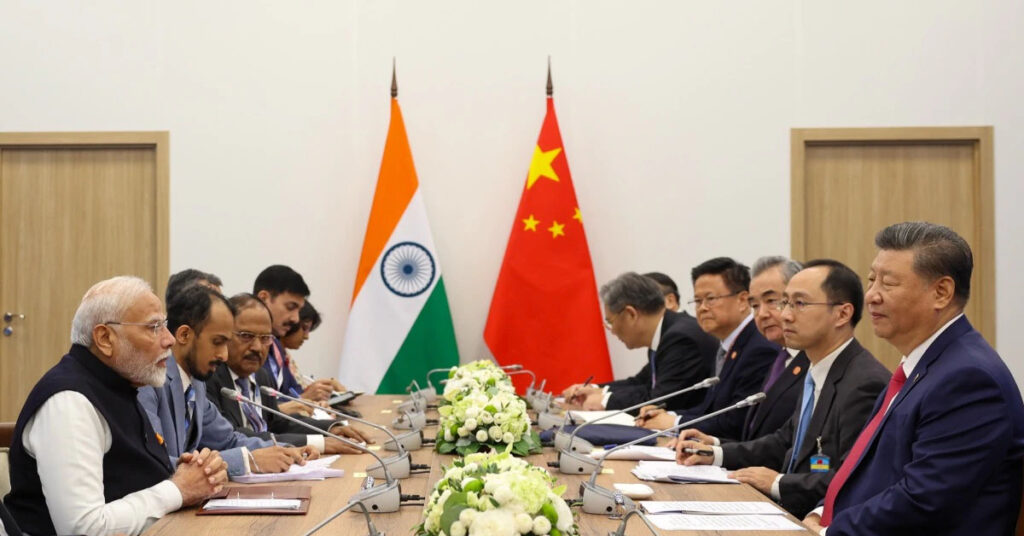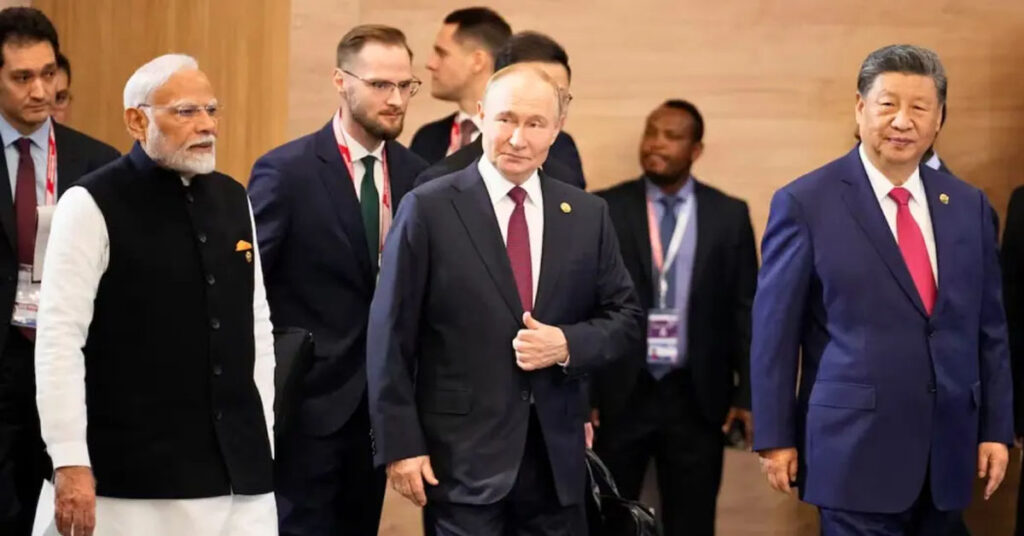Prime Minister Narendra Modi met Chinese President Xi Jinping on Sunday on the sidelines of the Shanghai Cooperation Organization (SCO) Summit in Tianjin. This high-profile meeting between the leaders of Asia’s two most populous nations comes amid strained border relations, rising trade dependency, and shifting global alliances. While the dialogue signals a possible thaw, experts caution that the road ahead remains complicated.
Modi–Xi Meeting: Talks on Border Stability and Cooperation
During the bilateral talks, Prime Minister Modi emphasized that the disengagement process at the Line of Actual Control (LAC) had created a “climate of peace and stability.” Referring to his previous discussion with Xi Jinping at the 2024 BRICS Summit in Kazan, Modi said relations between India and China had gained “a positive direction.”
He also highlighted recent progress, including the resumption of the Kailash Mansarovar Yatra and the restart of direct flights between the two countries. “The cooperation between India and China connects the interests of 2.8 billion people,” Modi said, stressing that mutual trust and sensitivity would guide future engagement.

In response, Xi Jinping described India and China as “ancient civilizations and major voices of the Global South.” He added that cooperation between the “dragon and the elephant” was crucial for the world at a time of geopolitical upheaval.
Why This Visit Matters: Modi’s First China Trip in Seven Years
This is Prime Minister Modi’s first visit to China in seven years. The last in-person meeting between the two leaders in China took place in 2018. Analysts note that India’s decision to participate physically in the SCO Summit—after hosting the 2023 edition virtually—signals a strategic recalibration.

The visit also comes at a time when India–U.S. relations face turbulence, particularly after Washington imposed steep tariffs on Indian exports. Some observers argue that Modi’s outreach to Beijing is partly aimed at balancing external pressure from the United States.
Border Disputes Still Cast a Shadow
Despite Modi’s optimistic tone, the reality on the ground remains tense. Since April 2020, the border standoff in Eastern Ladakh has not been fully resolved. China continues to assert claims over Arunachal Pradesh, which it refers to as “South Tibet,” and has even renamed several locations in Mandarin.
While India adheres to the One China Policy, recognizing Tibet and Taiwan as part of China, Beijing has not reciprocated with concessions on the LAC or other contentious issues. Defence experts warn that Beijing prefers to keep India under pressure while expanding its influence in the region.
India’s Economic Dependence on China Growing
Trade ties between India and China continue to deepen, albeit in Beijing’s favor. In 2024, bilateral trade stood at $127.7 billion, with India importing $48 billion worth of electronics and electrical equipment from China.
Although China is India’s second-largest trading partner, the imbalance raises concerns. Experts argue that China benefits disproportionately, while India struggles to diversify supply chains. “China wants friendship but on its own terms,” one defence analyst noted, adding that New Delhi has yet to secure concessions on trade, Tibet, or rare earth minerals.
The Russia–China Factor and India’s Strategic Dilemma
Another layer of complexity is Russia’s growing alignment with China. Historically, India’s close ties with Moscow were partly shaped by their shared unease with Beijing. But today, Russia–China relations are stronger than ever, leaving India in a delicate position.
“India faces the challenge that Russia now depends more on China than on its long-standing partnership with New Delhi,” analysts explain. This dynamic reduces India’s leverage in both defence and energy cooperation.
Experts Sound Caution: Can India Trust Beijing?
Several strategic commentators warn that New Delhi should remain cautious. Past experiences suggest that China exploits Indian vulnerabilities rather than acting as a reliable partner.
In 2014, Modi had entered office hopeful of improving relations, but Beijing quietly consolidated its military positions along the border while expanding infrastructure projects. More recently, China supplied Pakistan with real-time radar and satellite data during cross-border tensions with India, further eroding trust.
Adding to concerns, Beijing has confirmed plans to construct the world’s largest dam near India’s border, raising environmental and national security risks.
Balancing Between Washington and Beijing
For New Delhi, navigating between the United States and China is becoming increasingly difficult. While India values its partnership with Washington, analysts note that Modi is unlikely to bow to U.S. pressure, particularly under President Trump’s aggressive tariff policies.
“India will decide its oil purchases and foreign policy independently,” wrote foreign affairs expert Stanley Johny. “This does not mean Indo–U.S. relations are broken, but India knows it cannot afford to ignore China either.”
The SCO Summit also places Modi alongside Pakistani Prime Minister Shehbaz Sharif—marking their first face-to-face encounter since the Pahalgam terror attack and Operation Sindoor—adding yet another layer of geopolitical sensitivity.
Outlook: A Difficult Balancing Act Ahead
While the Modi–Xi meeting has been projected as a step toward stabilizing ties, experts remain sceptical. Beijing has given India little reason to believe that the current circumstances will be different from past disappointments.
Ultimately, India’s challenge lies in maintaining strategic autonomy. With the U.S. turning increasingly protectionist, Russia tilting toward China, and Beijing refusing to offer meaningful concessions, Modi must carefully balance engagement with caution.
The message from Tianjin is clear: dialogue continues, but trust remains fragile. The coming months will reveal whether India and China can move beyond rhetoric toward a genuinely stable partnership—or whether old disputes will once again define their relationship.










